What is Cost Accounting
What is Cost Accounting a systematic procedure for recording and reporting measurement of the unit cost of manufactured goods in the aggregate and detail? It includes methods for recognizing, classifying, allocating, aggregating, and reporting such costs and comparing them with standard costs. Often considered a subset of managerial accounting, its end goal is to advise the management on how to optimize business practices and processes based on cost efficiency and capability. Cost accounting provides detailed cost information that management needs to control current operations and plan for the future.
Cost accounting information is also commonly used in financial accounting, but its primary function is for use by managers to facilitate their decision-making.
Standard Cost Accounting
Standard costing allocates fixed costs incurred in an accounting period to the goods produced during that period. This allowed the full cost of products that were not sold in the period they were produced to be recorded as ‘inventory’ in the Balance sheet to be carried forward to the next accounting period, using a variety of complex accounting methods, which was consistent with the principles of GAAP (Generally Accepted Accounting Principles). It also essentially enabled managers to ignore the fixed costs, and look at the results of each period concerning the “standard cost” for any given product.
For Example: if the railway coach company normally produced 40 coaches per month, and the fixed costs were still $1000/month, then each coach could be said to incur an Operating Cost/overhead of $25 =($1000 / 40). Adding this to the variable costs of $300 per coach produced a full cost of $325 per coach.
This method tended to slightly distort the resulting unit cost, but in mass-production industries that made one product line, and where the fixed costs were relatively low, the distortion was very minor.
For Example: if the railway coach company made 100 coaches one month, then the unit cost would become $310 per coach ($300 + ($1000 / 100)). If the next month the company made 50 coaches, then the unit cost = $320 per coach ($300 + ($1000 / 50)), a relatively minor difference.
An important part of standard cost accounting is a variance analysis, which breaks down the variation between actual cost and standard costs into various components (volume variation, material cost variation, labor cost variation, etc.) so managers can understand why costs were different from what was planned and take appropriate action to correct the situation.
Throughput Accounting
As business became more complex and began producing a greater variety of products, the use of cost accounting to make decisions to maximize profitability came into question. Management circles became increasingly aware of the Theory of Constraints in the 1980s and began to understand that “every production process has a limiting factor” somewhere in the chain of production. As business management learned to identify the constraints, they increasingly adopted throughput accounting to manage them and “maximize the throughput dollars” (or other currency) from each unit of constrained resource.
Throughput accounting aims to make the best use of scarce resources (bottleneck) in a JIT (Just in time) environment. “Throughput”, in this context, refers to the amount of money obtained from sales minus the cost of materials that have gone into making them.
Activity-based costing
Activity-based costing (ABC) is a system for assigning costs to products based on the activities they require. In this case, activities are those regular actions performed inside a company. “Talking with the customer regarding invoice questions” is an example of activity inside most companies.
Companies may be moved to adopt ABC by a need to improve costing accuracy, that is, understand better the true costs and profitability of individual products, services, or initiatives. ABC gets closer to true costs in these areas by turning many costs that standard cost accounting views as indirect costs essentially into direct costs. By contrast, standard cost accounting typically determines so-called indirect and overhead costs simply as a percentage of certain direct costs, which may or may not reflect actual resource usage for individual items.
Under ABC, accountants assign 100% of each employee’s time to the different activities performed inside a company (many will use surveys to have the workers themselves assign their time to the different activities). The accountant then can determine the total cost spent on each activity by summing up the percentage of each worker’s salary spent on that activity.
A company can use the resulting activity cost data to determine where to focus its operational improvements. For example, a job-based manufacturer may find that a high percentage of its workers are spending their time trying to figure out a hastily written customer order. Via (ABC) Activity-based costing, the accountants now have a currency amount pegged to the activity of “Researching Customer Work Order Specifications”. Senior management can now decide how much focus or money to budget for resolving this process deficiency. Activity-based management includes (but is not restricted to) the use of activity-based costing to manage a business.
While (ABC) Activity-based costing may be able to pinpoint the cost of each activity and resources into the ultimate product, the process could be tedious, costly, and subject to errors.
As it is a tool for a more accurate way of allocating fixed costs into a product, these fixed costs do not vary according to each month’s production volume. For example, the elimination of one product would not eliminate the overhead or even direct labor cost assigned to it. Activity-based costing (ABC) better identifies product costing in the long run, but may not be too helpful in day-to-day decision-making.
Lean Accounting
Lean accounting has developed in recent years to provide the accounting, control, and measurement methods supporting lean manufacturing and other applications of lean thinking such as healthcare, construction, insurance, banking, education, government, and other industries.
There are two main thrusts for Lean Accounting. The first is the application of lean methods to the company’s accounting, control, and measurement processes. This is not different from applying lean methods to any other process. The objective is to eliminate waste, free up capacity, speed up the process, eliminate errors & defects, and make the process clear and understandable. The second (and more important) thrust of Lean Accounting is to fundamentally change the accounting, control, and measurement processes so they motivate lean change & improvement, provide information that is suitable for control and decision-making, provide an understanding of customer value, correctly assess the financial impact of lean improvement, and are themselves simple, visual, and low-waste. Lean Accounting does not require traditional management accounting methods like standard costing, activity-based costing, variance reporting, cost-plus pricing, complex transactional control systems, and untimely & confusing financial reports. These are replaced by:
- lean-focused performance measurements
- simple summary direct costing of the value streams
- decision-making and reporting using a box score
- financial reports that are timely and presented in “plain English” that everyone can understand
- radical simplification and elimination of transactional control systems by eliminating the need for them
- driving lean changes from a deep understanding of the value created for the customers
- eliminating traditional budgeting through monthly sales, operations, and financial planning processes (SOFP)
- value-based pricing
- correct understanding of the financial impact of lean change
As an organization becomes more mature with lean thinking and methods, they recognize that the combined methods of lean accounting in fact creates a lean management system (LMS) designed to provide the planning, the operational and financial reporting, and the motivation for change required to prosper the company’s on-going lean transformation.
Marginal Costing
The cost-volume-profit analysis is the systematic examination of the relationship between selling prices, sales, production volumes, costs, expenses, and profits. This analysis provides very useful information for decision-making in the management of a company. For example, the analysis can be used in establishing sales prices, in the product mix selection to sell, in the decision to choose marketing strategies, and in the analysis of the impact on profits by changes in costs. In the current environment of business, a business administration must act and take decisions in a fast and accurate manner. As a result, the importance of cost-volume-profit is still increasing as time passes.
CONTRIBUTION MARGIN
A relationship between the cost, volume, and profit is the contribution margin. The contribution margin is the revenue excess from sales over variable costs. The concept of contribution margin is particularly useful in the planning of business because it gives an insight into the potential profits that a business can generate. The following chart shows the income statement of a company X, which has been prepared to show its contribution margin:
CONTRIBUTION MARGIN RATIO
The contribution margin ratio measures the effect on an operating income of an increase or a decrease in sales volume. For example, assume that the management of Fusion, Inc. is studying the effect of adding $80,000 in sales orders. Multiplying the contribution margin ratio (40%) by the change in sales volume ($80,000) indicates that operating income will increase $32,000 if additional orders are obtained. To validate this analysis the table below shows the income statement of the company including additional orders:
What is Cost Accounting
Welcome to the Gutenberg Editor
The goal of this new editor is to make adding rich content to WordPress simple and enjoyable. This whole post is composed of pieces of content—somewhat similar to LEGO bricks—that you can move around and interact with. Move your cursor around and you’ll notice the different blocks light up with outlines and arrows. Press the
How to Increase Profit Margins Through Virtual CFO Services
How to Increase Profit Margins Through Virtual CFO Services

Great Accounting Firms Share These 10 Traits
Great Accounting Firms Share These 10 Traits which has gone far beyond the paper-pushing days and now involves acting as a virtual CFO

Tax Accountant in Miami Cope with IRS Tax Season Delay
Tax Accountant said IRS delays start of tax season for individual returns would be postponed until February 17 with some as late as March

Miami Accountants Philosophy of Up or Out
Its up or out for Miami Accountants firms are faced with the dilemma of keeping long-term managers that are not ready to be equity partners or let them go.

Contadores en Miami Explican Auditorías del IRS
Contadores en Miami, Gustavo A Viera CPA, explica los pasos de una auditoría, desde la notificación de la auditoría hasta el cierre de la misma
Home » Blog » Accountants in Miami » What is Cost Accounting

